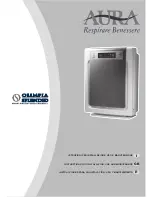
Page 10
Installer’s Guide
NOTE:
The unit is shipped for horizontal installation.
NOTE:
During heating operation, avoid supply air below 80
degrees F or return air below 50 degrees F to prevent flue
gas condensation.
Horizontal Airflow Units
1. Location of the unit must allow service clearance around it
to ensure adequate serviceability, maximum capacity, and
peak operating efficiency.
2. These units are designed for outdoor installation. They
may be installed directly on a slab, wood flooring, or on
Class A, B, or C roof covering material. The discharge air
from the condenser fans must be unrestricted for a minimum
of 3 feet above the unit.
3. The louvers above and below the flue hood in the side panel
must have adequate clearance around the air opening into
the combustion area. See Figure 2 on page 5 or Figure 4 on
page 7.
4. Examine all flue product-carrying areas of the furnace, its
vent system, and the main burner for safe operation.
IMPORTANT:
A minimum 0” clearance to combustible ma-
terial shall be maintained on air outlet duct.
5. Exhaust vents or other sources of contaminated air must not
be near the unit’s air inlet if outside air is to be introduced
as make-up air or a ventilation feature is to be used. Con-
tamination from exhaust vents or chimneys may also foul the
condenser causing degraded performance.
6. Check the handling facilities to ensure the safety of person-
nel and the unit(s).
7. The unit must be mounted level for proper drainage of water
through the drain holes in the base pan.
8. The unit should not be exposed to direct roof water runoff.
9. Flexible duct connectors must be of a flame retardant
material. All duct work outside of the structure must be
insulated and weatherproofed in accordance with local
codes.
10. Holes through exterior walls or roof must be sealed in
accordance with local codes.
11. All fabricated outdoor ducts should be as short as possible.
Clearances
1. The recommended clearances for single-unit installations
are illustrated in Figures 1 to 6, pages 4-9.
2. Any reduction of the unit clearances indicated in these
figures may result in condenser coil starvation or the recir-
culation of warm condenser air. Actual clearances, which
appear to be inadequate should be reviewed with a local
engineer.
3. See the unit’s nameplate for the absolute minimum clear-
ance between the unit and any combustible surfaces.
Down Airflow Units
1. Location of the unit must allow service clearance around it to
ensure adequate serviceability, maximum capacity, and peak
operating efficiency.
2. Refer to the Installation section for instruction on converting
the supply and return airflow covers to down airflow.
3. The field assembled Roof Mounting Curb (BAYCURB050A or
BAYCURB051A) or a field fabricated curb should be in place
before the unit is hoisted to the roof top.
The Roof Mounting Curb (frame) must be installed on a flat,
level section of the roof (maximum of 1/4" per foot pitch) and
provide a level mounting surface for the unit. Also, be sure to
provide sufficient height above the roof to prevent water from
entering the unit.
4. Be sure the mounting curb spans structural members (trusses)
of the roof, thereby providing sufficient support for the weight of
the unit, the curb, the duct(s), and any factory or field installed
accessories.
5. The unit must be mounted level for proper drainage of water
through the drain holes in the base pan.
6. Be sure the hole in the structure for the ducts is large enough
to accommodate the fabricated ducts and the insulation sur-
rounding them. Flexible duct connectors must be of a flame
retardant material. All duct work outside of the structure must be
insulated and weatherproofed in accordance with local codes.
7. Holes through exterior walls or roof must be sealed in accor-
dance with local codes.
8. These units are designed for outdoor installation. They may be
installed directly on a slab, wood flooring, or on Class A, B, or
C roof covering material. The discharge air from the condenser
fans must be unrestricted for a minimum of 3 feet above the
unit.
9. The louvers above and below the flue hood in the side panel
must have adequate clearance around the air opening into the
combustion area.
10. Examine all flue product-carrying areas of the furnace, its vent
system, and the main burner for safe operation.
IMPORTANT:
A minimum 0” clearance to combustible material
shall be maintained on air outlet duct.
11. Exhaust vents or other sources of contaminated air should not
be near the unit’s air inlet if outside air is to be introduced as
make-up air or a ventilation feature is to be used. Contamination
from exhaust vents or chimneys may also foul the condenser
causing degraded performance.
12. Check the handling facilities to ensure the safety of personnel
and the unit(s).
Clearances
1. The recommended clearances for single-unit installations are
illustrated in Figures 1 to 6, pages 4-9.
2. Any reduction of the unit clearances indicated in these fig-
ures may result in condenser coil starvation or the recircula-
tion of warm condenser air. Actual clearances, which appear
to be inadequate should be reviewed with a local engineer.
3. See the unit’s nameplate for the absolute minimum clearance
between the unit and any combustible surfaces.
Step 3—Review Location and Recommendation Information
Summary of Contents for 4DCZ6036
Page 5: ...Page 5 Installer s Guide Figure 2 4DCZ6036 2 of 3...
Page 6: ...Page 6 Installer s Guide Figure 3 4DCZ6036 3 of 3...
Page 7: ...Page 7 Installer s Guide Figure 4 4DCZ6048 through 4DCZ6060 1 of 3...
Page 8: ...Page 8 Installer s Guide Figure 5 4DCZ6048 through 4DCZ6060 2 of 3...
Page 9: ...Page 9 Installer s Guide Figure 6 4DCZ6048 through 4DCZ6060 3 of 3...











































